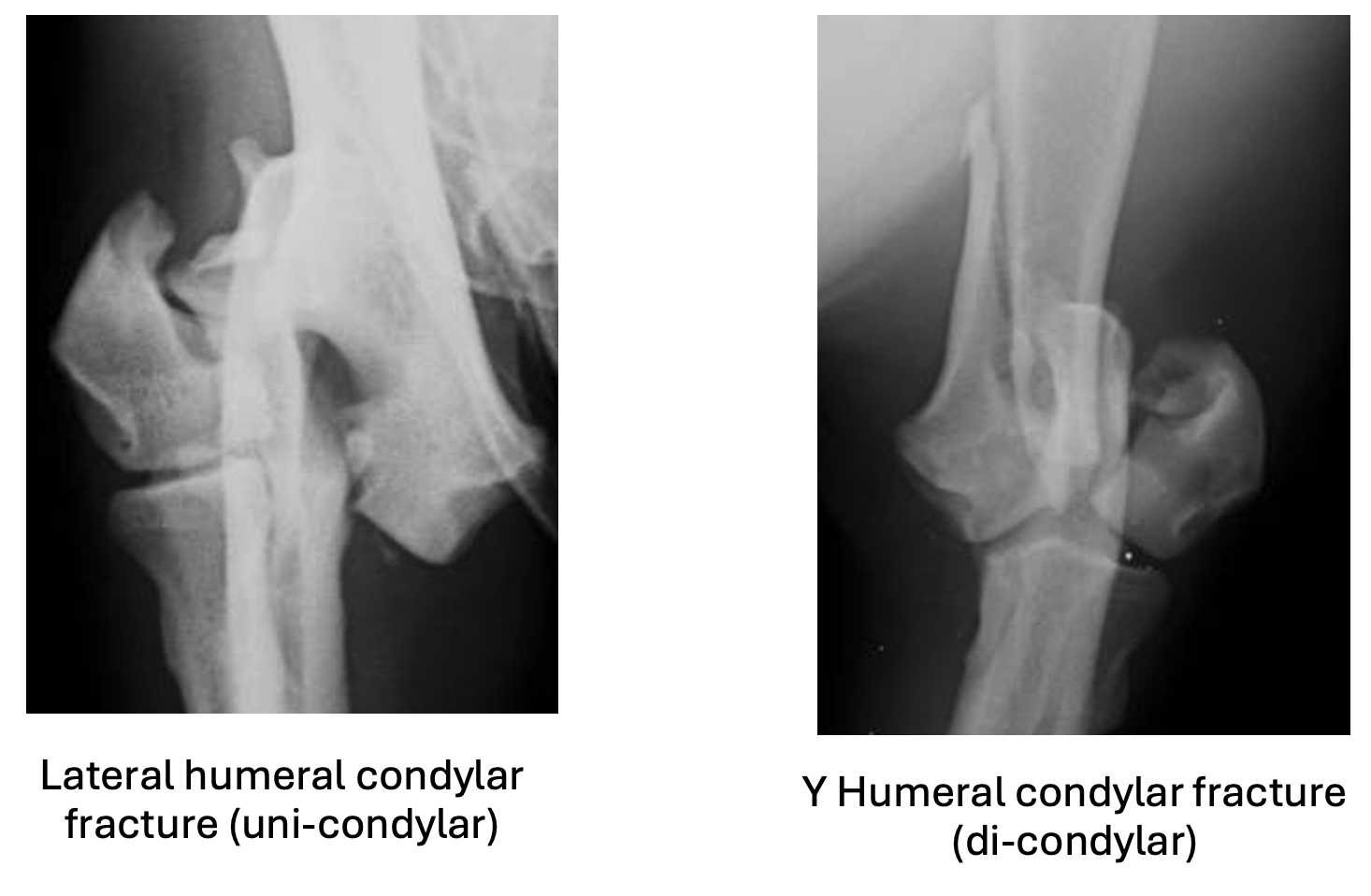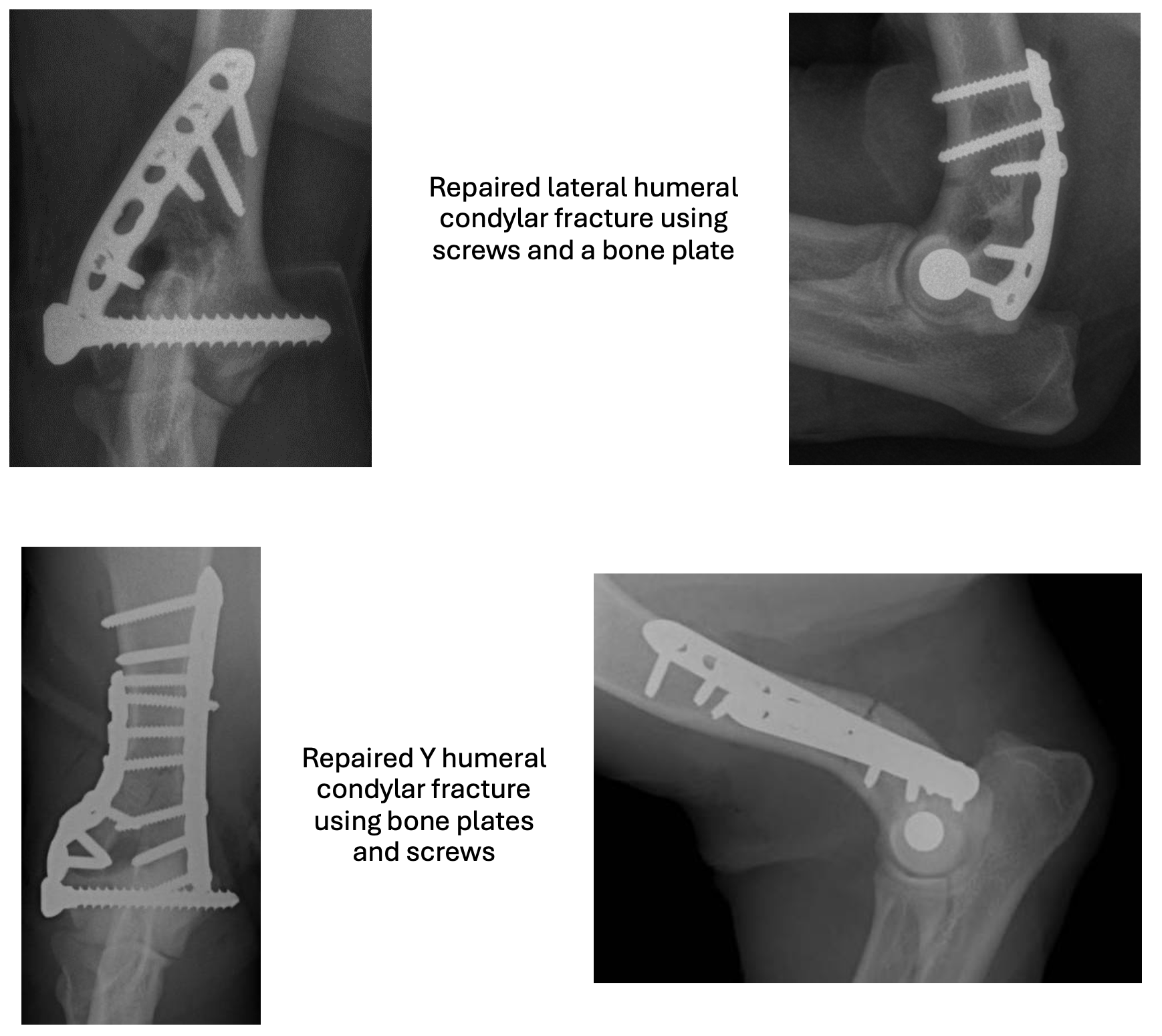Humeral Condylar Fractures

Where is the humerus bone and what is a humeral condylar fracture?
The humerus is a large bone in the front leg. Along with the scapula (shoulder blade) it forms the shoulder joint at the top and along with the radius and ulna (forearm) bones it makes up the elbow joint at the bottom. The bottom part of the humerus which fits together with the radius and ulna bones is called the humeral condyle, when broken the elbow joint is fractured. This is a very common fracture in dogs but occur rarely in cats.
Why does the humeral condyle fracture?
For many dogs, most commonly puppies, the humeral condyle will fracture because of jumping down from a height. For others, most commonly Springer Spaniels, the humeral condyle can break during periods of normal activity, as they have a weakness within their humeral condyle, a condition known as humeral intra-condylar fissure (HIF). Fractures are more likely to involve one half of the humeral condyle. These uni-condylar fractures most frequently affect the outside (lateral) half rather than the inside (medial) half. In some dogs both halves of the humeral condyle fracture. These di-condylar fractures tend to have a ‘Y’ or ‘T’ shaped pattern. Y and T fractures are some of the most difficult fractures we repair.
 What are the signs?
What are the signs?
Fracture of the humeral condyle will be associated with a sudden onset of lameness and pain in most pets. Lameness is generally severe with most pets being reluctant to put their leg on the ground. The elbow joint will often be swollen and will often feel “crunchy” if touched. Dogs who have humeral intra-condylar fissure will possibly have had a period of lameness in the same leg of variable duration which precedes the fracture.
How are humeral condylar fractures diagnosed?
Most humeral condylar fractures are readily apparent when your pet is examined. In some young puppies’ elbow pain may be readily apparent but palpation of a fracture much less so. X-rays obtained with the pet either sedated or under general anaesthesia will be required to make a diagnosis. For some patients a CT scan as well or instead of x-rays may be recommended by your surgeon to assess the fracture in more detail and to assist with surgical planning. For dogs suspected of having HIF, a CT may be recommended to check the elbow joint in their other front leg for this disease.
So, my pet’s fractured its humeral condyle, what now?
Humeral condylar fractures prevent the elbow joint from working as it should, and these fractures require surgery to fix them. As the elbow joint is involved, the jigsaw of broken pieces of bone has to be pieced back together as accurately as is possible. This gives the elbow joint the best chance of working as well as it can following the injury. The broken pieces of bone are secured in position using a combination of implants including screws, plates and sometimes pins.
 How long is the recovery?
How long is the recovery?
Most dogs will start walking on the operated leg within 1-3 days of surgery with continued progress occurring over the coming weeks. Your pet will receive painkillers for a few weeks after surgery. The recovery period following humeral condylar fracture repair is usually around 6-12 weeks to the point where the patient can be returned to normal activity levels. Strict activity restrictions, which may include a period of pen / crate confinement, are imposed for the first 4-6 weeks. Full postoperative management and activity instructions will be provided and explained by the team when you collect your pet after their surgery. Initial checks on the wound and removal of any skin stitches will be undertaken by your own vet, however a follow up appointment will be arranged with your surgeon towards the end of the recovery period to ensure that your pet has made expected progress. At this follow up x-rays will be obtained, most commonly under sedation rather than anaesthesia to check the implants and to assess fracture healing. If all is progressing as expected further rehabilitation guidelines will be given, and any further assessments scheduled. Unless indicated implants remain in place for life.
What is the outlook following surgery?
Some reduction in elbow range of motion and elbow osteoarthritis are expected to develop however for most dogs this will not cause significant mobility problems moving forward. Despite the complexity of some humeral condylar fractures most dogs will have a good to excellent outcome with most being expected to return to normal activity without the need for ongoing pain relief. A small number of dogs will retain some residual lameness and may require ongoing analgesic medication.
What are the potential complications following surgery?
Our surgeons will have a thorough discussion with you ahead of surgery to make sure you are fully informed regarding possible complications. If a complication develops your pet is likely to require assessment by your surgeon. Investigations including x-rays and elbow joint fluid collection and analysis may be required. Complications include such things as:
Complications that can be encountered include:
Infection – will require antibiotic medication ideally based on the results of sample analysis. For some patients’ infection may necessitate further surgery for it to be resolved.
Implant problems such as loosening or breakage – These are uncommon complications. There can be several different reasons for implant problems developing. Most implant problems will necessitate further surgery.
Wound problems – Whilst these can be seen following any surgery, the risk is small. As with any surgery swelling of the soft tissues and bruising should be expected; these should resolve within a few days of surgery.





